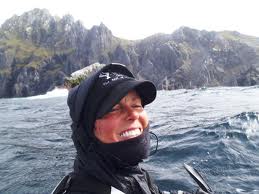Kayaker Hoffmeister Conquers The Cape
 Article by Joe Glickman.
Article by Joe Glickman.
No stretch of water on the planet is as feared as the legendary passage around Cape Horn.
Its gale-force winds, rogue waves, icebergs and summertime blizzards have sunk more than 800 ships.
Freya Hoffmeister intended to paddle around it, and was 2,333 miles into her attempt to become the first person to circumnavigate South America by kayak.
She had spent Christmas Day camped on Isla Navarino, one of the many islands that make up Tierra del Fuego.
Cape Horn – Cabo de Hornos to the locals – is the southernmost island. She could have cut inside and paddled in more protected water, but that’s not the Hoffmeister way. The next morning she packed her kayak in darkness and set out for what she hoped would be a 50-mile paddle to the Cape.
For the first 10 hours, the seas were subdued; the wind, at least in the lee of the islands, nearly still. At 2:30 PM she rounded Isla Herschel. There, rising 1,400 feet above sea level, loomed the stark profile of Cape Horn. Just six miles to go, Freya thought, and this prize is mine.
But 30 minutes later a sudden wind jumped her like a mugger. She pushed on, slowed to 2 mph. Now just half a mile remained – but she was being shoved out to sea, heading towards Antarctica. She’d walked straight into the Cape Horn trap.
Her only option was retreat. Six miles later, she faced rows of cold ugly breakers crashing on the boulder-strewn southern shore of Isla Deceit. She surfed a slot through two rocks, leapt out, and slipped.
The next wave tossed her boat on the rocks, damaging the rudder and cracking the seams. The paddle she'd used to round Australia snapped in two. Fighting the wind, she managed to erect her tent behind a shoulder-high boulder and wedged her boat beneath it.
And there she sat, pinned down for five days as Cape Horn roared. The wind gusted up to 80 mph, tearing at her tent and literally blowing rocks off the cliffs behind. She had plenty of time to regret not turning back sooner – “the worst decision of my kayaking life," she says.
When she managed to place a phone call to her boyfriend in Demark, hoping to be cheered up, she learned that a paddler who had befriended her in Buenos Aires, Alejandro Carranza, had drowned while paddling further north.
One afternoon the rain stopped long enough for her to repair her kayak. But when she hustled out of her tent the next morning, waves "as big as houses" were imploding on the beach. The noise made sleep almost impossible. She worried about falling rocks, mourned the death of her friend, and wondered how long before she could escape. By day five, she was eating half-rations.
On New Year's Day, the wind dropped to 20 knots. And she had discovered a more "sheltered" spot where kelp beds muted the breaking waves. Sweating in her dry suit, her stomach in knots, she launched from a flat, slippery boulder, paddled past the breakers, and was free.
Two hours later, she reached the ramp below the Naval Station on Cape Horn just as a load of cruise ship passengers wobbled ashore. Exhausted, Freya sat on the dock, hoping that no one would ask how she'd spent New Year's Eve. Luckily, most were too hung over to even notice that she was there.
Joe Glickman is a recipient of the Lowell Thomas Award for travel writing. His work has appeared in Outside, Men’s Journal, National Geographic Adventure, Backpacker, Canoe & Kayak, and leading national newspapers. His books include To The Top and The Kayak Companion. He is also the author of Fearless: One Woman, One Kayak, One Continent, and he blogs here. This article courtesy of Canoe & Kayak.
- Tags: adventure goals inspiration sports success
Related Articles
- Dee Caffari (Yachtswoman)
- 92-year-old Sky Diver Still Finding Adventure
- Sylvia Earle's TED Prize Wish To Protect Our Oceans
- Fancy A Career Change? How About Rowing Solo Across Two Oceans?
- Roz Savage: Why I'm rowing across the Pacific
- Roz Savage (Ocean Rower)
- Freya Hoffmeister (Kayaker/Adventurer)
- Nellie Bly (Journalist/Adventurer)
- Ann Bancroft (Arctic Explorer/Teacher/Adventurer)
- Sylvia Earle (Oceanographer / Explorer)